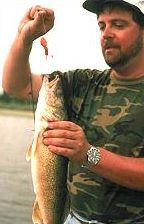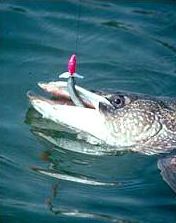Forget about “finesse” all the time! Savvy jig anglers are going to 5/8 to 1 1/2 ounce jigs to trigger strikes, and to achieve precision lure placement and absolute depth control.
The steep, rolling waves of Lake Erie were tossing our heavy fiberglass, 20-foot, boat around like it was a 10-foot aluminum johnboat. It was impossible to cast and retrieve a lure with any feel, and nearly impossible to stand in the boat. But what bothered me more than the high winds was the fact we were drifting past schools of big walleyes with ineffective presentations.
Out of desperation to reach the 25-foot depths and maintain some feel, I tried on a 1-ounce jig and baited it with a good-size minnow. After the jig was lowered to the bottom, my 6-foot graphite rod was set in a rod holder. More hard drifting with the jig being pulled fairly high off the bottom by the stiff graphite rod produced no takers. The drift speed was too fast and the jigs action was too violent in these cold waters of early spring.
To slow our drift speed, I began to run our motor into the wind, Not in an effort to move against it, but to reduce our drift speed. A “wind sock” would have accomplished the same task, had we brought one along.
The next move was to switch to a longer rod (7-foot) that had a softer action. The soft action would absorb some of the wave’s energy that was lifting the jig several feet off the bottom while the stiffer rod was used. A final adjustment was to put a stringer treble hook on the back of the jig. Normally this is done to hook short-striking fish, but in this instance the object was to hook fish via the wave action, as the small sharp trailing treble would easily barb them.
We began to re-drift the runs that showed fish on our sonar unit with renewed confidence. Strikes began coming almost immediately, as walleye after walleye were pulled over the gunnel of our boat. Our adjustments worked! It was just a matter of depth and speed control, something structure fishing guru Buck Perry has been preaching for many years.
Oversized, jumbo jigs have saved the day for me on many occasions. I’ve used them slow, fast, dressed with plastic, hair, live bait or combinations thereof. Big jigs are especially effective in deeper water, stronger currents, during faster drifts or when you want to maintain bottom contact while using a faster retrieve or trolling speed.
In recent years the trend has been more toward finesse presentations. Lighter lines, smaller lures and more “gentle” retrieves have been the rule. But fish usually are caught because they feed, strike or are protecting their nests. Certain lures provoke strikes. Crankbaits, spinner baits, and faster-moving surface lures are some top lures that trigger a fish’s predatory nature, thus causing them to react to (strike) a lure. Live bait, slow-moving plastics and standard, jig-type lures often tempt a fish into biting.
While jigs are generally thought of as finesse lures, they can also be worked fast to trigger strikes since they give you enough weight to maintain bottom contact under faster speeds. Heavier jigs add a new dimension to using live bait-enabling it to provoke strikes by more speed control. Lets examine some of the ways big jigs can help you catch more gamefish.
Walleyes
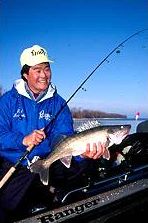
Jumbo jigs also work great for walleyes and sauger when slow trolling along a structure or going against the current in a river. A boat that drifts down wind in a lake, or with the current in a river cannot be manipulated along precise edges very accurately, especially if tight turns exist. But if you slowly “backtroll” (run a smaller HP outboard motor in reverse against the wind) your boat can be slowly moved along a difficult-to-fish edge with more precision than can be achieved with any other control method. This slow accurate boat control method, combined with a near vertical presentation that allows you to feel out the bottom, is particularly deadly along erratic tough-to-fish edges (Note: “backtrolling” can also be accomplished by using a powerful bow-mounted electric motor. But be sure it has plenty of power and fully charged batteries).
While “line watching” plays a big part in most jig fishing, it’s not a big factor when jumbo jigs are used. You’ll easily feel the big dull thud when your 5/8 ounce or heavier jig pounds the bottom. Actually, these big jigs are like you eyes under the water, easily telegraphing back to you strikes, changes in bottom composition and cover. If you pay attention, you even be able to note subtle depth changes of a foot or two-even depressions in the bottom.
Ted Takasaki and John Campbell are two top walleye tournament anglers who have had outstanding success while trolling big jigs slowly up current in rivers. This innovative pair of anglers who captured the Masters Walleye Circuit “Team of the Year” honors in 1991, started out using heavy jigs as replacements for weights on 3-way rigs (river rigs) instead of the more commonly used bell-shaped sinkers. Soon they began catching walleyes and saugers on their “weights”, with the jig-caught fish usually being larger than the ones caught on the trailing live bait.
In shallower rivers that lack much structure, deeper runs in the 10 to 20 foot range often hold plenty of fish, especially there the river makes a broad, sweeping turn. While most anglers would work this stretch with a controlled drift and present a jig or Lindy Rig with live bait as vertical a possible, savvy river anglers would also “jumbo jig it”, while slowly motoring against the current.
Big jigs baited with large minnows present a large profile that appeals to out-size walleyes. Often this big lure worked in a fast manner is the only way to produce lunker walleyes under certain conditions.
Big jigs will reach bottom with the minimum amount of line out. This will give you great feel, lure placement and a way to totally control a lures action. You can hover over (by going into the wind or current) a few scattered deep rocks, short point, tight turn or sharp ledge and hold the jig inches above bottom while quivering the rod tip to entice a strike, or jump the lure sharply to provoke a reaction.
Stinger hooks are often helpful in hooking short-hitting fish.
Northern Pike
While large jigs dressed with plastics or big minnows have been touted as a top pike presentation in Fishing Facts for years, this was generally thought of a an early season presentation (in flatter areas) one used for following fish, or when casting into the weeds.
In the last few years trolling these big jigs just outside the weedline (or ripping through short deep fringe weeds), along deep drop-offs or across sunken clean humps, or into sharp turns has produced very well for me.
The key again is depth and speed control. I can put a larger jig right where I want it, control the action, have tremendous feel and hook a high percentage of strikes.
Most of my success has come along erratic edges that most anglers find hard to fish. The more points and sharp turns the better, and if a wind is pounding into the structure or edge making boat control difficult, I consider this a bonus.
My favorite big jig for this fishing is Lindy Little Joe’s Lil’ Hummer. This 5/8 or 1 ounce jig has a propeller that produces flash plus a lot of extra vibration that seems to attract and excite pike.
A Lindy Little Hummer jig worked fast along a deep weed edge triggered this big pike.
When fishing slower because the water is cold, or the pike are not too active, the jig will usually be dressed with a Fuzz-E-Grub body and baited with a large minnow. I’m also more apt to backtroll and use the 5/8 ounce model, working it with a gentle lift and drop motion. But if the pike are active and not over 20-25 feet deep, them the fun begins as I crank up the trolling speed by going forward, increase jig size and begin to rip the 1-ounce offering off the bottom. At this point a plastic dressing with more action would be preferred, such as a double Swirltail, 3 1/2 inch or larger tube jig, 4 1/2 inch Slug-Go or large plastic minnow with an “action tail”. If you still want to tip this faster lure presentation with live bait, the double Swirltail works best, as the twin tails flap along side the minnow.
In deep clear lakes pike often herd suspended baitfish such as ciscoes, shad, herring or tulibees into sharp corners or “inside turns” (opposite of a point-this where the deep water swings in toward shore). These conditions in the 20-50 foot depth range are almost impossible for the average angler to troll with any speed and live bait on a slip sinker rig is a slow process that won’t trigger strikes from non-feeding fish. It also results in hooking quite a few fish too deep for their own well being. But a one ounce or larger jig dressed with a hard-headed baitfish, and/or a glued on (Krazy Glue, Super Glue, etc.) plastic dressing can be worked slow, fast or somewhere in between with precision control on those hard to hit spots.
When fishing deeper than the major weed edge in a lake for pike, consider using large jigs with keel-shaped heads. The narrow profile on these heads allow the lure to easily cut throughout the water, making it the best design for deep water, currents or faster retrieves (or trolling speeds) while still maintaining bottom contact. The lures line tie will usually be set back from the jig’s tip, which makes this design more suited for use over cleaner bottoms.
Lake Trout
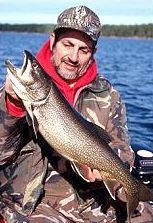
During the warm months lake trout will school up around the deepest holes in a lake. You’ll find these hard-pulling trout where good structures such as deep shelves, points or humps are adjacent to at least 70-80 foot depths.
My plan of attack is to drift along the edges of these deep holes, from a structure out toward deeper water, or right across the hole if the depth isn’t too extreme (over 150 feet). Sometimes the fish are on bottom-sometimes they are suspended.
I usually start drifting from the top of a structure toward deeper water. The line is released off the reel so the big jig will plummet quickly toward the bottom. Once it reaches bottom the rate the line was peeling out will lessen. In calmer water this is easy to notice, but on windy days you must keep a watchful eye on the line. Once the jig hits bottom your retrieve begins.
Some successful deep water jig fishermen just reel the lure back to the boat at a moderate rate of speed. When the lure is in sight, the line is released and the scenario is repeated. Other anglers, such as myself, use a straight retrieve sprinkled with periodic pauses, twitches and short bursts of speed that help trigger following fish.
When fishing big jigs I generally use a Fuzz-E-Grub body and bait such as a strip of sucker meat (with skin attached), large minnow or strip of gullet cut off another fish. This short grub body adds a little bulk and color, and doesn’t interfere with the action of the live bait.
Tackle Tips
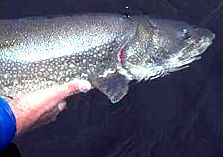
A bait-casting reel with a smooth, dependable drag and a flipping mode is recommend. I can quickly let out line if the lure needs to drop down a ledge or depression while using only one hand, if the reel had flipping switch feature. Actually, you can easily slow troll with a powerful electric motor and use a rod in each hand, if the correct tackle is used.
When vertical jigging for lake trout the ultimate set up is to use a line counter reel so you know exactly the depth level where hits are occurring. This is a real bonus when fish are suspended. South Bend’s Vanguard Line Counter reels are perfect for vertical jigging. The smallest model will hold plenty of line for any freshwater situations.
I spool up my reels with good abrasion-resistant line such as Trilene XT, because of all the bottom bumping that takes place. In recent years I’ve spooled up with the new ultra-thin “super braided” lines when fishing extra deep water or when maximum feel was needed. Excellent success was achieved with Berkley’s FireLine and WhipLash in the 20 to 30-pound test range.
Jumbo jigs aren’t magic but they do give you another effective tool to add to your fishing arsenal. They allow you to fish faster, deeper in stronger currents and with maximum feel and lure placement. Don’t just think of using them in the ways I’ve outlined. What about for striped bass in the fast waters below dams? Or along the edges of deep holes in a river when baited with a large minnow for giant catfish? How about deep water muskies when dressed with an oversize plastic dressing? The uses are many. It’s time to get on the big jig bandwagon for more fishing success!
